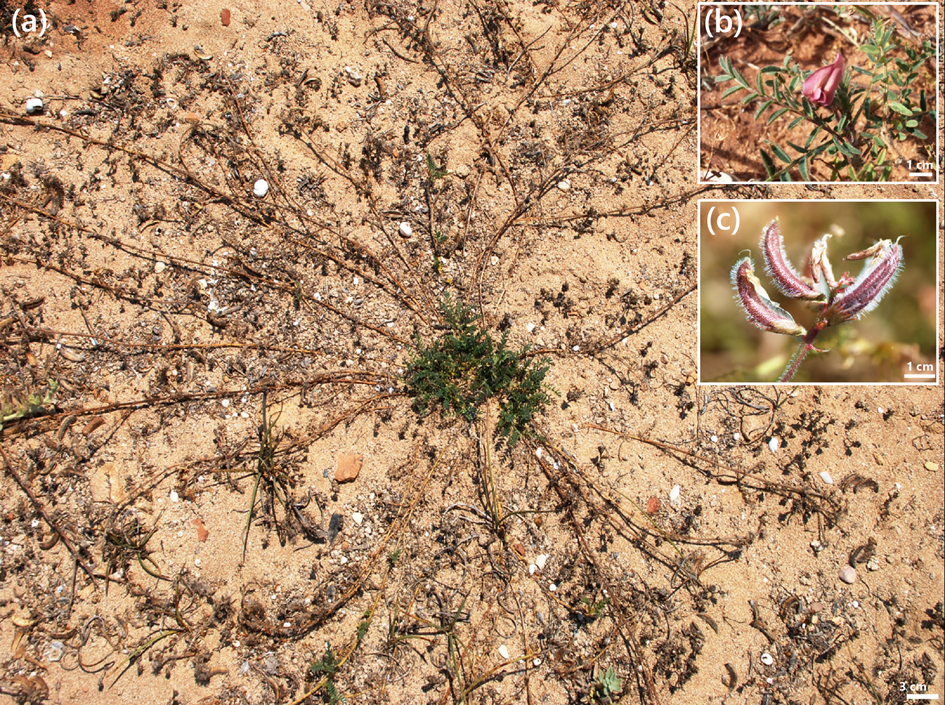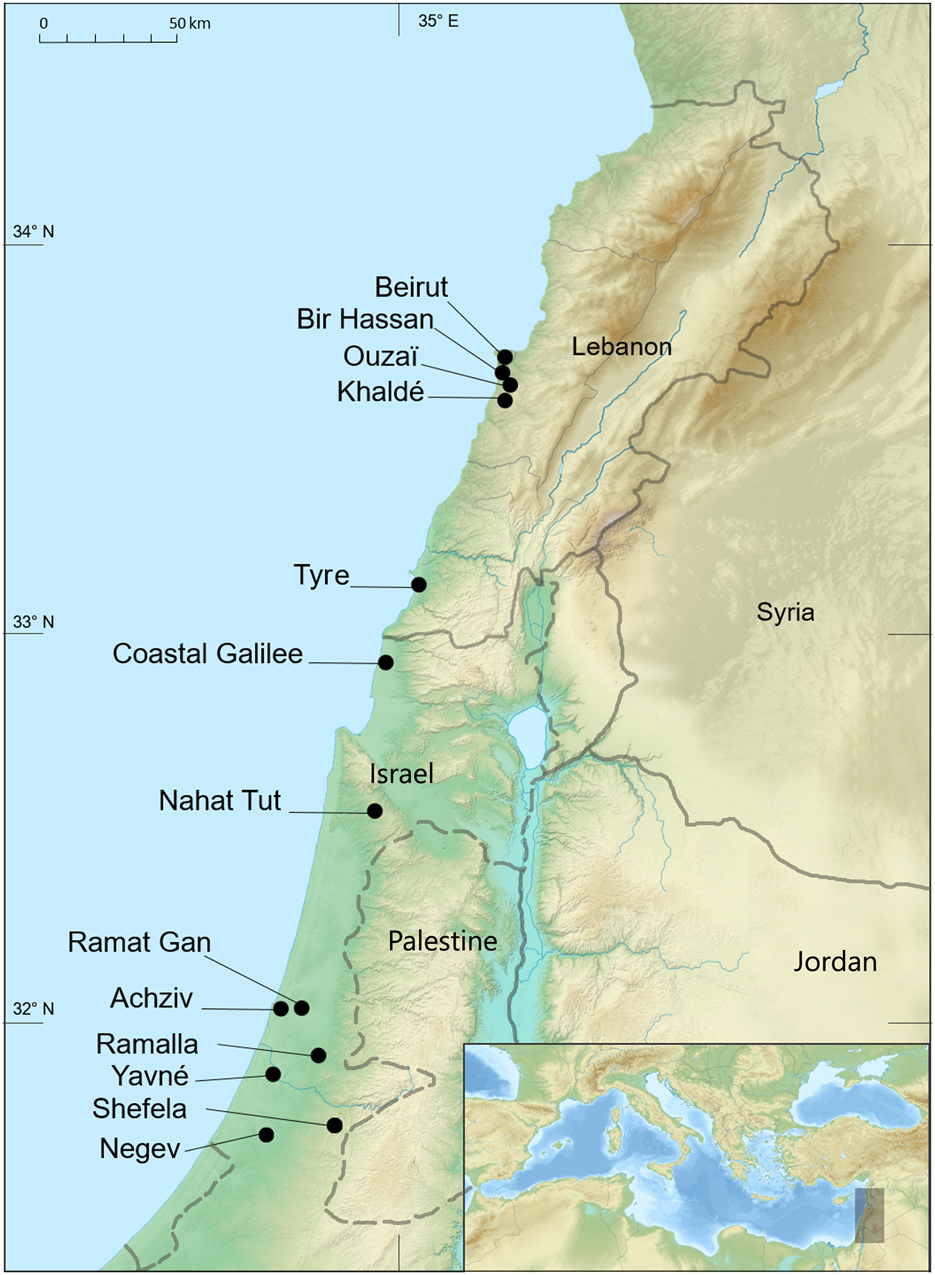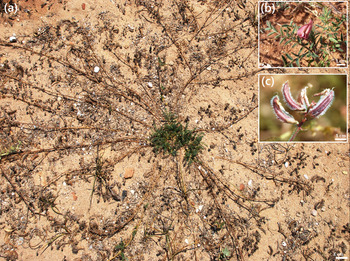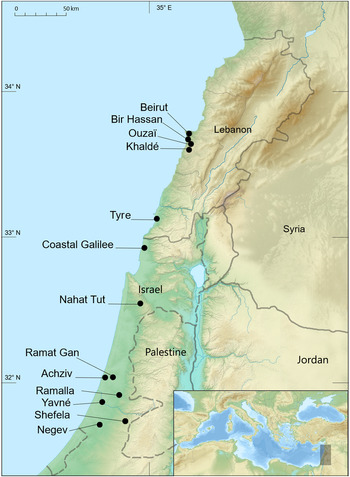Coastal vegetation includes unique species with adaptations to the specific conditions of this environment (Voronkova et al., Reference Voronkova, Burkovskaya, Bezdeleva and Burundukova2008). In the Mediterranean region urban development of coastal areas has severely affected coastal ecosystems and led to loss of biodiversity (Doxa et al., Reference Doxa, Albert, Leriche and Saatkamp2017). In Lebanon, one of the 10 regional biodiversity hotspots in this region (Médail & Myers, Reference Médail, Myers, Mittermeier, Robles Gil, Hoffmann, Pilgrim, Brooks, Mittermeier, Lamoreaux and da Fonseca2004), the increase in the human population and intensive urbanization has destroyed one-third of the 220 km coastline (MOE, 2004).
Astragalus berytheus Boiss. & Blanche (Plate 1) is a coastal species endemic to Lebanon and Palestine/Israel (Tohmé & Tohmé, Reference Tohmé and Tohmé2014), and one of the most threatened taxa in Lebanon (MOE, 2004). It occurs in prime tourist areas, such as sandy beaches, which are targeted for the establishment of resorts. These habitats are categorized as highly threatened because of extensive tourism throughout the Mediterranean (IUCN, 1994). Here we assess the conservation status of A. berytheus, using the IUCN Red List criteria (IUCN, 2012), and make appropriate recommendations for its conservation.

Plate 1 Astragalus berytheus in Tyre Nature Reserve: (a) plant photographed in May, (b) flowers and leaves photographed in March, and (c) immature seed pods photographed in April.
Information on the historical distribution of A. berytheus was gathered from regional floras (Mouterde, Reference Mouterde1984; Tohmé & Tohmé, Reference Tohmé and Tohmé2014) and herbaria (Royal Botanic Garden Edinburgh Herbarium, Herbarium WU at University of Vienna, and MNHN Paris). During 1994–2018, all sandy shores along the coast of Lebanon were visited by GT and HT to determine the species’ occurrence. Historically the species was known from five localities in Lebanon (Fig. 1, Supplementary Table 1).

Fig. 1 Present and historical distribution of Astragalus berytheus on the eastern Mediterranean coast (see Supplementary Table 1 for additional details). The only extant population in Lebanon is in Tyre Coast Nature Reserve (see text for details).
Three of the five Lebanese populations (Beirut, Ouzaï and Khaldeh) were already extinct when we began this study in 2009. The coastal strip was severely damaged by the construction of the highway connecting Beirut to southern Lebanon and the construction of Beirut airport in 1997. The last population in the Beirut area (Bir Hassan) became extinct following construction of a residential building in 2015. This population was in an area of 1,000 m2 and was characterized by annual fluctuation in the number of individuals: eight in 2010, 14 in 2013 and five in 2014.
The only extant population of A. berytheus in Lebanon is in an area of c. 2,000 m2 in Tyre Coast Nature Reserve. In 2013 there were > 20 individuals, bearing healthy fruits and seeds. These were, however, affected by the invasion of camphor-weed Heterotheca subaxillaris (Lam.) Britton & Rusby (Family Asteraceae), which originated from the USA; it is an invader of coastal sand dunes (Sternberg, Reference Sternberg2016) and was introduced into the Middle East in 1975 (di Castri et al., Reference di Castri, Hansen and Debussche1990). It was first observed in the Reserve in 1999 (Tohmé & Tohmé, Reference Tohmé and Tohmé2009), and in 2015 it invaded A. berytheus habitat. Eradication has, however, allowed A. berytheus to recover (Bou Dagher Kharrat et al., Reference Bou Dagher Kharrat, Farhat, Dakik, Kahale, Chahine and Potash2016), with 32 individuals recorded in 2016 and 76 individuals bearing fruits in 2019.
We calculated the AOO (area of occupancy) and the EOO (extent of occurrence) of A. berytheus using the Geospatial Conservation Assessment Tool (Bachman et al., Reference Bachman, Moat, Hill, de la Torre, Scott, Smith and Penev2011), considering the Lebanese population and the populations in Palestine/Israel (Danin & Fragman-Sapir, Reference Danin and Fragman-Sapir2016; Supplementary Table 1). With an EOO of c. 945 km2 and an AOO of c. 36 km2, A. berytheus should be categorized as Endangered based on criteria B2ab(ii); i.e. with AOO < 500 km2 (B2), severely fragmented (a) and projected decline of quality of habitat b(ii).
Nationally in Lebanon, A. berytheus should be categorized as Critically Endangered based on criteria A2ac; B1B2ab(i, ii, iii, iv); C2b; i.e. with a population reduction observed of > 80% and where the causes of reduction may not be reversible (A2) and direct observation (a) of decline in AOO and EOO (c), with an EOO < 100 km² (B1) and an AOO < 10 km² (B2) showing only one location (a) and a continuing decline of EOO (i), AOO (ii), quality of habitat (iii), and number of subpopulations (iv), and with < 250 mature individuals in the wild (C2) and extreme fluctuations in the number of mature individuals (b).
Passive habitat protection is not a guarantee of long-term plant conservation (Martinell et al., Reference Martinell, López-Pujol, Blanché, Molero and Sàez2011), and the last A. berytheus population in Lebanon would probably have been extirpated if encroachment of the invasive H. subaxillarisi had not been halted. Plant species known from only one or two populations, growing in areas with some protection, are known to have gone extinct (Bañares et al., Reference Bañares, Marrero, Carqué and Fernández2003). Appropriate planning of local management actions, with recovery plans for individual species (Fenu et al., Reference Fenu, Mattana and Bacchetta2011; Ballesteros et al., Reference Ballesteros, Foronda, Cañadas, Peñas and Lorite2013; Cambrollé et al., Reference Cambrollé, Mancilla-Leytón, Muñoz-Vallés, Morenza-Barrera and Figueroa2018), are required for successful plant conservation. Environmental monitoring, population viability analysis and population genetics and studies of reproductive biology are required to support the conservation of A. berytheus. The micro-reserve concept (Laguna et al., Reference Laguna, Ballester, Fabregat, Olivares, Serra and Deltoro2001), for the monitoring and in situ conservation of threatened plants in small protected areas, could be appropriate for A. berytheus and for other narrow endemic species of Lebanon, such as Matthiola crassifolia Boiss. & Gaill. (Bou Dagher Kharrat et al., Reference Bou Dagher Kharrat, El Zein and Rouhan2018).
In 2013, 28 pods of A. berytheus were collected from the Bir Hassan population (before it vanished), containing a total of 112 seeds, but only nine seeds escaped infestation by a chalcid wasp Bruchophagus sp. (Hymenoptera: Eurytomidae) often associated with the seeds of legumes (Burks, Reference Burks1957). Theses seeds, together with some seeds collected from the Tyre Coast Nature Reserve in 2011 were stored in the Laboratory of Seed Germination and Conservation–Jouzour Loubnan at Saint-Joseph University, Beirut, Lebanon.
In 2020, 50 plantlets grown from ex situ germination of these seeds will be introduced to the Tyre archaeological site, 3 km from Tyre Nature Reserve, with similar ecological conditions. As the archaeological site is a UNESCO world heritage site this will facilitate protection and monitoring. The presence of endemic plants on archaeological sites is an opportunity to raise the conservation awareness of visitors (Siljak-Yakovlev et al., Reference Siljak-Yakovlev, Tan, Tsounis and Tsounis2011).
A national legal framework is required to halt the loss of biodiversity in Lebanon, especially of narrow endemics plant species (Médail & Baumel, Reference Médail and Baumel2018), working from the principle that the narrower the range of a taxon the greater the local responsibility (Gauthier et al., Reference Gauthier, Debussche and Thompson2010). An additional imperative to conserve A. berytheus is that it bears the name of Beirut, the nation's capital. If the results of the pilot introduction of the species to the Tyre archaeological site are favourable, future introductions could be considered in other suitable coastal locations.
Acknowledgements
This research was supported by a PhD grant from the National Council of Scientific Research of Lebanon and from Critical Ecosystem Partnership Fund grant #108497.
Author contributions
Fieldwork: FAS, GT, HT; writing: FAS, FM, MBDK, AB, SSY.
Conflicts of interest
None.
Ethical standards
This research complied with the Oryx guidelines on ethical standards.




